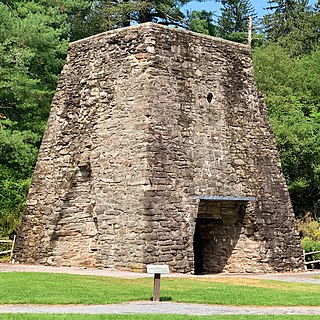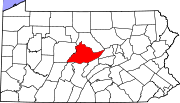Related Research Articles
Midlothian is an unincorporated community and census-designated place (CDP) in Allegany County, Maryland, United States; at one time it was called Midlothian Junction. As of the 2010 census it had a population of 320. Its ZIP code is 21543.
The Bellefonte Central Railroad was a shortline connecting Bellefonte and State College, Pennsylvania. Constructed in the late 19th century to haul local iron ore to furnaces in the Bellefonte region, it later hauled freight traffic to Penn State and lime for steelmaking from local quarries. The line to State College was abandoned in 1974, and most of the remaining railroad in 1984, but a small portion is still used by the Nittany and Bald Eagle Railroad.
The Catasauqua and Fogelsville Railroad was built in the 1850s to transport iron ore from local mines in Lehigh and later Berks County to furnaces along the Lehigh River in eastern Pennsylvania. Originally owned by two iron companies, the railroad later became part of the Reading Company, and parts of it remain in operation today.
The Central Railroad of Pennsylvania was a short railroad of 27.3 miles (43.9 km) built to connect Bellefonte, Pennsylvania with the Beech Creek Railroad at Mill Hall, Pennsylvania. Sustained by shipments from the Bellefonte iron industry, the abandonment of the iron furnaces there led to its demise in 1918.
The Nittany Valley Railroad was a Pennsylvania shortline built to haul iron ore to blast furnaces near Bellefonte.
Scotia was an American village that was located in Patton Township, Centre County, Pennsylvania, at 40°47′59″N77°56′46″W. Although the community was called Scotia, the name of the local post office was Benore.
The Mont Alto Rail Road was a railroad in Franklin County, Pennsylvania, originally built to connect the blast furnaces of the Mont Alto Iron Company to the Cumberland Valley Railroad. It was later extended south to reach Waynesboro.

Pine Grove Furnace State Park is a protected Pennsylvania area that includes Laurel and Fuller Lakes in Cooke Township of Cumberland County. The Park accommodates various outdoor recreation activities, protects the remains of the Pine Grove Iron Works (1764), and was the site of Laurel Forge (1830), Pine Grove Park (1880s), and a brick plant (1892). The Park is 8 miles (13 km) from exit 37 of Interstate 81 on Pennsylvania Route 233.

The Katahdin Iron Works is a Maine state historic site located in the unorganized township of the same name. It is the site of an ironworks which operated from 1845 to 1890. In addition to the kilns of the ironworks, the community was served by a railroad and had a 100-room hotel. The site was listed on the National Register of Historic Places in 1969.
Struble is an unincorporated community in Ferguson Township, Centre County, Pennsylvania, United States.
John Wesley Gephart was a Bellefonte, Pennsylvania lawyer and industrialist. Educated in Bellefonte and at Princeton University, Gephart's diligence and intelligence were already marked when he was admitted to the bar at the end of 1876 and joined the Bellefonte law practice of James A. Beaver in 1877. He took a prominent part in the civic and moral life of the town, and enjoyed a reputation as a skillful lawyer and charismatic orator. In 1891, he became president of the newly organized Valentine Iron Company, and thereafter became increasingly devoted to furthering industry and commerce in his home town. He laid aside his legal practice in 1893, after becoming the superintendent of the new Central Railroad of Pennsylvania, to become a full-time industrialist.

Nittany Furnace, known earlier as Valentine Furnace, was a hot blast iron furnace located in Spring Township, Centre County, Pennsylvania, United States. Placed in operation in 1888 on the site of an older furnace, it was an important feature of Bellefonte economic life until it closed in 1911, no longer able to compete with more modern steel producers.
The Lewisburg and Tyrone Railroad, previously the Lewisburg, Centre and Spruce Creek Railroad, was a subsidiary of the Pennsylvania Railroad (PRR) in central Pennsylvania. Originally intended to connect the Susquehanna Valley with Tyrone and the ore lands to its northeast, it was built in two discontinuous and never-connected pieces, one from Tyrone to Fairbrook and one from Lewisburg to Lemont. These served as lightly trafficked branches of the PRR into the early 20th Century. The line from Tyrone to Fairbrook passed into the hands of the short line Bellefonte Central Railroad in 1927, but the PRR's manipulations ensured its abandonment in 1941. The line between Lewisburg and Lemont was severed in 1970 and was gradually cut further back towards Montandon. Regular service ended on the last remaining part of the line in 1997, and it was abandoned in 2008.
Edmund Blanchard was a lawyer and prominent businessman in Centre County, Pennsylvania. He was an early promoter of rail transportation in the area.

Bellefonte Furnace was a hot blast iron furnace located in Bellefonte, Pennsylvania. Founded in 1888, it was the first hot blast, coke-fueled iron furnace to be built in Centre County, Pennsylvania. While its founders hoped to transform Centre County's iron industry with modern technology, the furnace struggled to operate at a profit and was out of operation from 1893 until 1899. Thereafter, it operated more or less continuously until 1910, and was demolished four years later. It should not be confused with the charcoal-fueled Bellefonte Furnace and Forge on Logan Branch, which was replaced by Valentine Furnace.

The Ironton Railroad was a shortline railroad in Lehigh County, Pennsylvania. Originally built in 1861 to haul iron ore and limestone to blast furnaces along the Lehigh River, traffic later shifted to carrying Portland cement when local iron mining declined in the early 20th century. Much of the railroad had already been abandoned when it became part of Conrail in 1976, and the last of its trackage was removed in 1984.

The Buffalo and Susquehanna Railroad was a railroad company that formerly operated in western and north central Pennsylvania and western New York. It was created in 1893 by the merger and consolidation of several smaller logging railroads. It operated independently until 1929, when a majority of its capital stock was purchased by the Baltimore and Ohio Railroad. At the same time, the B&O also purchased control of the neighboring Buffalo, Rochester, and Pittsburgh Railway. The Baltimore and Ohio officially took over operations of both roads in 1932.

The South Mountain Railroad was a southcentral Pennsylvania railway line for "connecting the Pine Grove works to the Cumberland Valley R. R." and which provided mining and passenger services via a southwest section from Hunter's Run, Pennsylvania, and a northern section from Hunter's Run to the CVRR junction northeast of Carlisle. The northern section merged with the Gettysburg & Harrisburg Railroad line south from Hunter's Run to the Gettysburg Battlefield in 1891 to create the Gettysburg & Harrisburg Railway line, while the branch southwest from Hunter's Run became the Hunter's Run and Slate Belt Railroad line.

The Pine Grove Iron Works was a smelting facility in southcentral Pennsylvania during the Industrial Revolution. The works is notable for remaining structures that are historical visitor attractions of Pine Grove Furnace State Park, including the furnace stack of the Pine Grove Furnace. The site was listed on the National Register of Historic Places on April 13, 1977 for its significance in architecture and industry. It includes seven contributing buildings, two structures, fourteen sites, and two objects.
Jayville was a hamlet located in the southwest part of St. Lawrence County, New York, in the United States. The hamlet started as a mining community in 1850 on what eventually became the Carthage and Adirondack Railroad. Its existence was short lived as its non-favorable mineral composition and difficult ore availability was abandoned in favor of neighboring Benson Mines, located 14 miles (23 km) down the railroad to the east. After mining stopped in the community, other industries such as saw mills kept the population busy. Ultimately, these business were short lived. A further attempt to reopen the mines in 1914 failed and an eventual fire ended the existence of the hamlet of Jayville. Today remnants of the hamlet can be found off the now abandoned railroad station located on New York State owned land southeast of Harrisville on Jayville Road.
